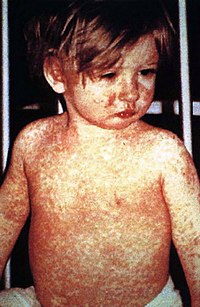
Photo from wikipedia
Background Diffuse pigmented villonodular synovitis (DPVNS) is a challenging tumor-like disorder that mainly occurs in the anterior aspect of the knee joint. The growth may sometimes extend to the posterior… Click to show full abstract
Background Diffuse pigmented villonodular synovitis (DPVNS) is a challenging tumor-like disorder that mainly occurs in the anterior aspect of the knee joint. The growth may sometimes extend to the posterior knee joint. Surgical excision is the mainstream treatment for DPVNS, and the posterior approach of tumor excision is adopted when the dominant tumor shows posterior extension. However, the optimal surgical approach over the posterior knee remains unknown. Methods Patients with DPVNS of the knee joint who received the posterior approach of synovectomy from 1995 to 2019 were retrospectively reviewed to describe the modified separate posterior (SP) approaches, and evaluate the treatment outcomes in a case series of DPVNS knees. The results of the SP approach was also compared with those of traditional direct posterior (DP) approach. Postoperative functional outcomes were evaluated using the Western Ontario and McMaster Universities Osteoarthritis Index (WOMAC) standardized questionnaire and clinician-completed Musculoskeletal Tumor Society (MSTS) functional rating system at outpatient department. Results A total of 20 DPVNS knees were included. Thirteen patients who received SP approaches were included in the SP group, while seven patients who received the DP approach were included in the DP group. The median follow-up times were 5.7 years (IQR, 2-8.8) in the SP group and 3 years (IQR, 2-5.3) in the DP group. Both groups showed satisfactory safety. The SP group presented higher postoperative mean WOMAC (91.23 ± 7.20) and mean MSTS (24.23 ± 2.68) than the DP group (mean WOMAC: 76.00 ± 16.57; mean MSTS: 22.43 ± 4.69). The Wilcoxon signed-rank test was use to compare preoperative and postoperative range of motion (ROM) for each group. The significant difference in SP group ( p = 0.004) was found while p = 0.131 in DP group. Conclusions The SP approach provides an effective approach with satisfactory outcomes for the surgical treatment of DPVNS knees.
Journal Title: BMC Musculoskeletal Disorders
Year Published: 2022
Link to full text (if available)
Share on Social Media: Sign Up to like & get
recommendations!